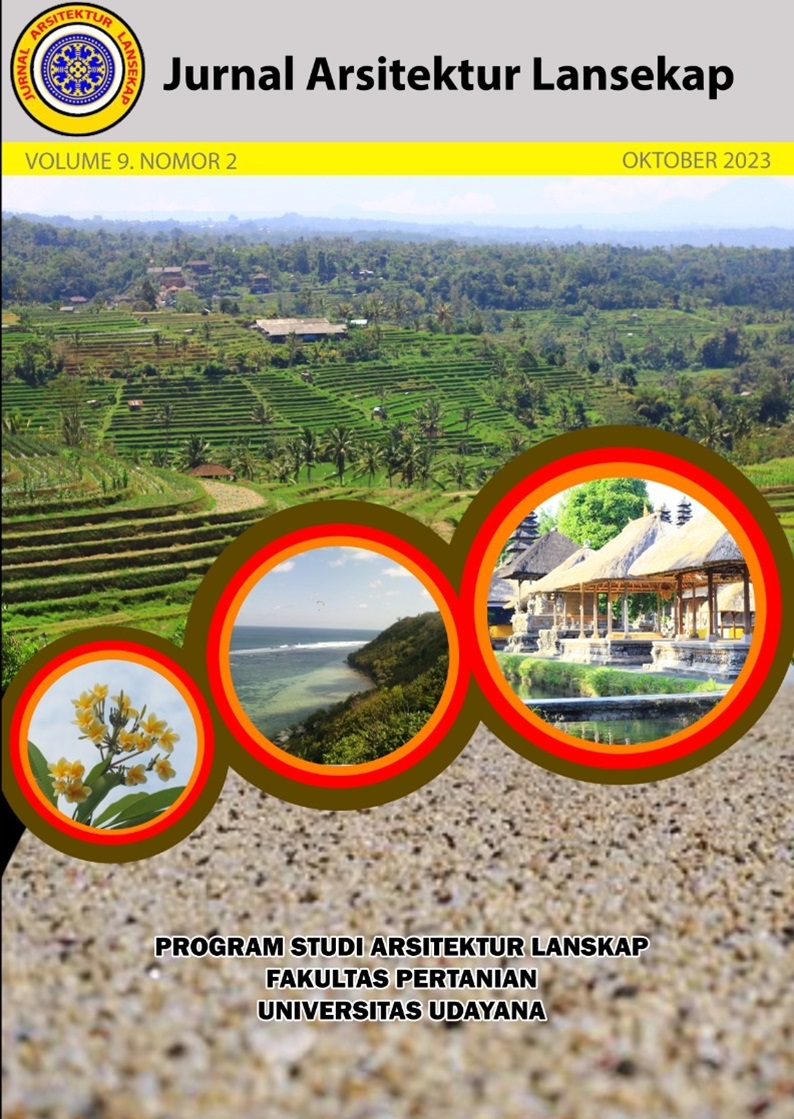Identifikasi Taman Telajakan di Desa Penglipuran, Kecamatan Bangli, Kabupaten Bangli
Abstract
Identification of the Telajakan Park in Penglipuran Village, Bangli District, Bangli Regency. Penglipuran Village is one of the Tourism Villages in Bangli Regency which is unique in its spatial pattern and building architecture, including the telajakan garden. However, the arrangement of the telajakan garden in the Penglipuran Village area which is a tourist destination with an area that is not a tourist destination has a quite different arrangement. The purpose of this study was to identify the function, pattern of the telajakan garden and the enthusiasm of the community in managing and preserving the telajakan garden in Penglipuran Village. This research was conducted by survey method with data collection techniques in the form of interviews, questionnaires, field observations and literature study. Based on the research that has been done, the results show that the Telajakan garden in Penglipuran Village has a function as a support for tourist attractions, as a space or distance between the walls of the house and the highway, as a green open space, a place to stick a penjor, other supporting elements such as a place to stick a flag, strengthen the walls of the pengengker, as well as a place to socialize the community. The pattern of the telajakan garden in the area within the Penglipuran Village with the outskirts of the Penglipuran Village has differences, among others, in the angkul-angkul section and the position of the telajakan garden. The enthusiasm of the people of Penglipuran Village in preserving the telajakan garden is very high, the telajakan garden in Penglipuran Village is fully regulated in the awig-awig of Penglipuran Village. It is hoped that the community will continue to maintain the sustainability and beauty of the telajakan garden as a green open space and a cultural heritage of Balinese traditional gardens.
Downloads
References
Dwijendra, N. K. A. (2010). Arsitektur Rumah Tradisional Bali. Udayana University Press. Denpasar.
Dwijendra, N.K.A. (2013). “Telajakan” Ruang Terbuka Hijau Tradisional Bali. Jurnal New Media Vol 4 No. 2
September (2013): 44-76
Kelurahan Kubu Kecamatan Bangli Kabupaten Bangli. 1989. Awig-awig Desa Adat Penglipuran.
Pemda Provinsi Bali. (2019). Perda Bali nomor 4 Tahun 2019 tentang Desa Adat di Bali. Pemda Provinsi Bali.
Denpasar, Bali.
Supriadi. (1993). Populasi dan Sampel Penelitian. Majalah Triwulan UNISIA No. 17 Tahun XIII Triwulan VI.
Universitas Islam Indonesia.
Warsito, H. (1992). Pengantar Metodologi Penelitian. Gramedia Pustaka Utama. Jakarta.
Windia, W. P. (2010), Dari Bali Mawacara Menuju Bali Santi. Udayana University Press. Denpasar.

This work is licensed under a Creative Commons Attribution-ShareAlike 4.0 International License.
An author who publishes in the Jurnal Arsitektur Lansekap (JAL) agrees to the following terms:
- Author retains the copyright and grants the journal the right of first publication of the work simultaneously licensed under the Creative Commons Attribution-ShareAlike 4.0 License that allows others to share the work with an acknowledgement of the work's authorship and initial publication in this journal
- Author is able to enter into separate, additional contractual arrangements for the non-exclusive distribution of the journal's published version of the work (e.g., post it to an institutional repository or publish it in a book) with the acknowledgement of its initial publication in this journal.
- Author is permitted and encouraged to post his/her work online (e.g., in institutional repositories or on their website) prior to and during the submission process, as it can lead to productive exchanges, as well as earlier and greater citation of the published work (See The Effect of Open Access).
Read more about the Creative Commons Attribution-ShareAlike 4.0 Licence here: https://creativecommons.org/licenses/by-sa/4.0/.







